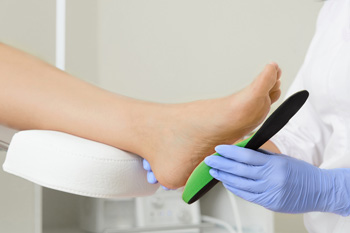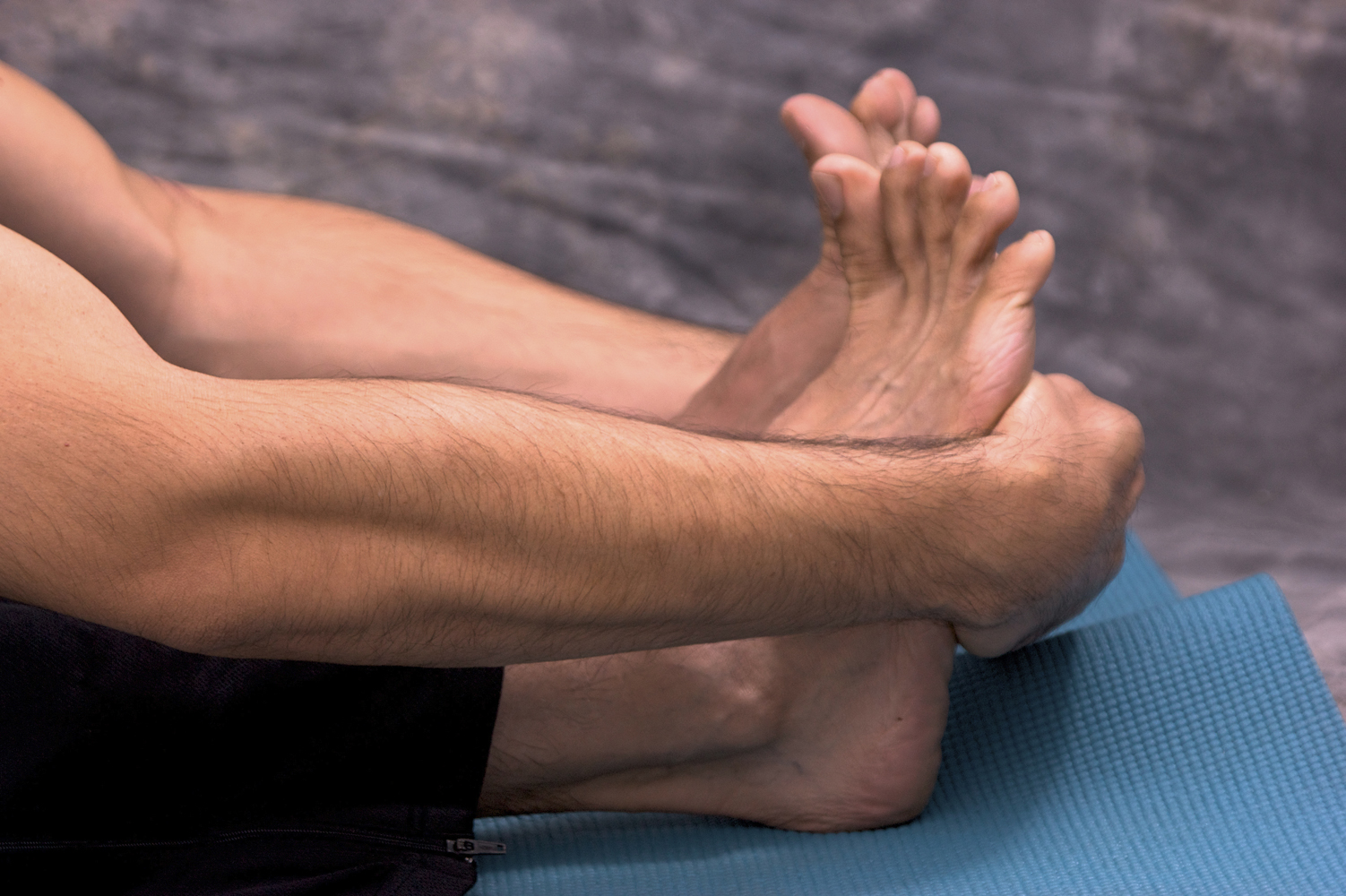
Orthotics are shoe inserts that help redistribute pressure, improve gait and posture, and cushion sensitive parts of the feet. The can also help to absorb shock and reduce foot pain. People with certain conditions that can benefit from orthotics include plantar fasciitis, lower limb injuries, flat feet or high arches. Patients with pronation or supination may also find a better distribution of pressure and equilibrium when orthotics are worn. Most people seem to benefit while some kind of orthotic is worn, either custom-made inserts or those that can be purchased over-the-counter. If you would like to know more about this pain-saving device, it is suggested that you visit a podiatrist to see if you are a good candidate for custom orthotics.
If you are having discomfort in your feet and would like to try orthotics, contact one of our podiatrists from McKinney Podiatric Associates, PA. Our doctors can provide the care you need to keep you pain-free and on your feet.
What Are Orthotics?
Orthotics are inserts you can place into your shoes to help with a variety of foot problems such as flat feet or foot pain. Orthotics provide relief and comfort for minor foot and heel pain but can’t correct serious biomechanical problems in your feet.
Over-the-Counter Inserts
Orthotics come in a wide variety of over-the-counter inserts that are used to treat foot pain, heel pain, and minor problems. For example, arch supports can be inserted into your shoes to help correct overarched or flat feet, while gel insoles are often used because they provide comfort and relief from foot and heel pain by alleviating pressure.
Prescription Orthotics
If over-the-counter inserts don’t work for you or if you have a more severe foot concern, it is possible to have your podiatrist prescribe custom orthotics. These high-quality inserts are designed to treat problems such as abnormal motion, plantar fasciitis, and severe forms of heel pain. They can even be used to help patients suffering from diabetes by treating foot ulcers and painful calluses and are usually molded to your feet individually, which allows them to provide full support and comfort.
If you are experiencing minor to severe foot or heel pain, it’s recommended to speak with your podiatrist about the possibilities of using orthotics. A podiatrist can determine which type of orthotic is right for you and allow you to take the first steps towards being pain-free.
If you have any questions please contact one of our offices located in Pasadena, Baytown, League City, Houston, and Pearland,TX . We offer the newest diagnostic and treatment technologies for all your foot and ankle needs.

Individuals might choose to stretch their feet for any number of reasons. This is because stretching the feet offers a range of different health benefits. For example, some individuals opt to incorporate foot stretches into their daily health routine because they can increase flexibility, mobility, and range of motion in the feet. Additionally, others choose to stretch their feet because of the soothing capacity of the stretches. In other words, stretching the feet can soothe pain. Pain felt from plantar fasciitis in particular can be soothed by performing certain foot stretches. Rolling the bottoms of the feet on a frozen water bottle can effectively stretch out and soothe the plantar fascia. If you are someone that wants to soothe foot pain through stretches, it is suggested that you contact a podiatrist for treatment.
Stretching the feet is a great way to prevent injuries. If you have any concerns with your feet consult with one of our podiatrists from McKinney Podiatric Associates, PA. Our doctors will assess your condition and provide you with quality foot and ankle treatment.
Stretching the Feet
Being the backbone of the body, the feet carry your entire weight and can easily become overexerted, causing cramps and pain. As with any body part, stretching your feet can serve many benefits. From increasing flexibility to even providing some pain relief, be sure to give your feet a stretch from time to time. This is especially important for athletes or anyone performing aerobic exercises, but anyone experiencing foot pain or is on their feet constantly should also engage in this practice.
Great ways to stretch your feet:
Individuals who tend to their feet by regular stretching every day should be able to minimize foot pain and prevent new problems from arising.
If you have any questions, please feel free to contact one of our offices located in Pasadena, Baytown, League City, Houston, and Pearland,TX . We offer the newest diagnostic and treatment technologies for all your foot care needs.

Poor circulation can cause tingling sensations, and the feet may feel cold. This generally occurs in the feet and may happen from sitting with the legs crossed for extended periods. Poor circulation can occur from medical conditions like high blood pressure, heart disease, and obesity. It may also happen from smoking, eating unhealthy foods, or from leading a sedentary lifestyle. Blood flow may be disrupted if there is an injury to the foot, and poor circulation may develop as the wound heals. This condition may be remedied when a healthy lifestyle is chosen, including engaging in a gentle exercise routine and eating foods that are low in fat. If you have symptoms of poor circulation, it is strongly suggested that you speak with a podiatrist who can help you to manage this condition.
While poor circulation itself isn’t a condition; it is a symptom of another underlying health condition you may have. If you have any concerns with poor circulation in your feet contact one of our podiatrists of McKinney Podiatric Associates, PA. Our doctors will treat your foot and ankle needs.
Poor Circulation in the Feet
Peripheral artery disease (PAD) can potentially lead to poor circulation in the lower extremities. PAD is a condition that causes the blood vessels and arteries to narrow. In a linked condition called atherosclerosis, the arteries stiffen up due to a buildup of plaque in the arteries and blood vessels. These two conditions can cause a decrease in the amount of blood that flows to your extremities, therefore resulting in pain.
Symptoms
Some of the most common symptoms of poor circulation are:
Treatment for poor circulation often depends on the underlying condition that causes it. Methods for treatment may include insulin for diabetes, special exercise programs, surgery for varicose veins, or compression socks for swollen legs.
As always, see a podiatrist as he or she will assist in finding a regimen that suits you. A podiatrist can also prescribe you any needed medication.
If you have any questions, please feel free to contact one of our offices located in Pasadena, Baytown, League City, Houston, and Pearland,TX . We offer the newest diagnostic and treatment technologies for all your foot care needs.

A small calcium deposit that forms between the heel and the arch of the foot may indicate a heel spur. It may happen as a result of an underlying health condition or possibly from wearing shoes that do not fit correctly. A heel spur can vary in shape, including pointed, hooked, or shelf-like, and can be up to a half-inch long. It can extend to the middle of the foot and cause the plantar fascia to become painful. A heel spur may occur from the natural aging process when the heel pads do not provide adequate shock absorption as they wear down. The symptoms include sharp heel pain, which may be more prominent in the morning, and the heel may be swollen and inflamed. An X-ray is generally performed that can provide an accurate diagnosis, and this can be followed by beginning treatment. If you have a heel spur, it is suggested that you confer with a podiatrist who can offer you relief options.
Heel spurs can be incredibly painful and sometimes may make you unable to participate in physical activities. To get medical care for your heel spurs, contact one of our podiatrists from McKinney Podiatric Associates, PA. Our doctors will do everything possible to treat your condition.
Heels Spurs
Heel spurs are formed by calcium deposits on the back of the foot where the heel is. This can also be caused by small fragments of bone breaking off one section of the foot, attaching onto the back of the foot. Heel spurs can also be bone growth on the back of the foot and may grow in the direction of the arch of the foot.
Older individuals usually suffer from heel spurs and pain sometimes intensifies with age. One of the main condition's spurs are related to is plantar fasciitis.
Pain
The pain associated with spurs is often because of weight placed on the feet. When someone is walking, their entire weight is concentrated on the feet. Bone spurs then have the tendency to affect other bones and tissues around the foot. As the pain continues, the feet will become tender and sensitive over time.
Treatments
There are many ways to treat heel spurs. If one is suffering from heel spurs in conjunction with pain, there are several methods for healing. Medication, surgery, and herbal care are some options.
If you have any questions feel free to contact one of our offices located in Pasadena, Baytown, League City, Houston, and Pearland,TX . We offer the latest in diagnostic and treatment technology to meet your needs.

New mothers often want to ensure that they are doing everything they possibly can to take care of their own health and the health of their new baby. One question that pregnant women sometimes ask medical professionals, such as podiatrists, is what kind of socks they should be wearing while they carry their baby to term. Importantly, it is helpful to note that the answer might depend on each individual patient’s needs. However, generally speaking, wearing compression socks might be helpful for some pregnant women. The reason for this is that they can help in reducing swelling in the feet and lower legs, a common symptom of pregnancy. By wearing compression socks, a pregnant woman may also be able to avoid blood clots, another issue that may arise during pregnancy. If you are pregnant or are planning to be, it is recommended that you contact a podiatrist for advice on how to protect your feet during pregnancy.
Pregnant women with swollen feet can be treated with a variety of different methods that are readily available. For more information about other cures for swollen feet during pregnancy, consult with one of our podiatrists from McKinney Podiatric Associates, PA. Our doctors will attend to all of your foot and ankle needs.
What Foot Problems Can Arise During Pregnancy?
One problem that can occur is overpronation, which occurs when the arch of the foot flattens and tends to roll inward. This can cause pain and discomfort in your heels while you’re walking or even just standing up, trying to support your baby.
Another problem is edema, or swelling in the extremities. This often affects the feet during pregnancy but tends to occur in the later stages.
How Can I Keep My Feet Healthy During Pregnancy?
If you have any questions please feel free to contact one of our offices located in Pasadena, Baytown, League City, Houston, and Pearland,TX . We offer the newest diagnostic and treatment technologies for all your foot and ankle needs.